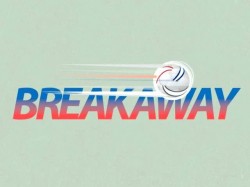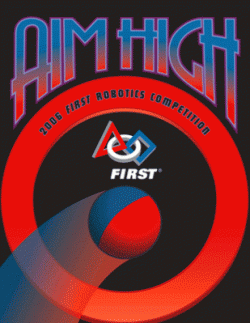2010
 Game: The game in 2010 was Breakaway. Robots are trying to move soccer balls into their goals. Robots may not possess more than one ball at a time, but they may herd and kick multiple balls at a time. Balls must be touching the ?oor while being moved by a robot. Only one robot at a time can block the opponent’s goals.
Game: The game in 2010 was Breakaway. Robots are trying to move soccer balls into their goals. Robots may not possess more than one ball at a time, but they may herd and kick multiple balls at a time. Balls must be touching the ?oor while being moved by a robot. Only one robot at a time can block the opponent’s goals.
Strategy: In this competition, Team 1403’s strategy was to play defensively. This was because we had difficulty holding and herding balls.
Outcome: In the New Jersey Regional in Trenton, Team 1403 had a record of 1-5-3. In the New York City Regional, Team 1403 was rank 31 with a record of 2-4-2 and won the Creativity Award sponsored by Xerox. In the Boston Regional, Team 1403 was rank 42 with a record of 6-6-2. In the Galileo Division, Team 1403 was rank 54 with a record of 3-6-1.
2009
 The Game: The game, Lunacy, is played on a low-friction field. Each robot has payload trailers. There are three game pieces of varying value. Robots must collect game pieces and place them in the trailers of the opposing robots.
The Game: The game, Lunacy, is played on a low-friction field. Each robot has payload trailers. There are three game pieces of varying value. Robots must collect game pieces and place them in the trailers of the opposing robots.
The Outcome: In the New Jersey Regional, Team 1403 had a record of 2-5-0. In the Philadelphia Regional, Team 1403 was rank 35 with a record of 4-5-0 and won the Chrysler Team Spirit Award. In the Connecticut Award, Team 1403 was rank 24 with a record of 4-4-0.
2008
The Game: The game in 2008 was FIRST Overdrive. Robots must make as many laps as possible going counter-clockwise around a track while moving trackballs over and/or under the overpass that bisects the track.
The Outcome: In the New Jersey Regional, Team 1403 was rank 53 with a record of 2-6-0 and won the Regional Engineering Inspiration Award. In the Florida Regional, Team 1403 was rank 33 with a record of 4-4-0. In the New York City Regional, Team 1403 was rank 24 with a record of 8-6-0. In Monty Madness, Team 1403 had a record of 2-6-0.
2007
The Game: The game was Rack ‘n Roll. The object of the game is to attain the highest score possible by placing game pieces on the central goal structure and by having robots in their home zone and not in contact with the playing field at the end of the match.
The Outcome: In the New Jersey Regional, Team 1403 was Rank 15 with a record of 4-4-1 and won the Regional Engineering Inspiration Award. In the Boston Regional, Team 1403 was rank 12 with a record of 9-6-0 and won the Motorola Quality Award. In the Archimedes Division, Team 1403 was rank 54 with a record of 3-4-0.
2006
 The Game: The game was Aim High. Robots must launch balls into the center goal for 3 points. Robots or human players may score a single point by throwing or pushing balls into the corner goals. Balls must stay in the goal and exit via the exit chute to count for a score. Human players may retrieve balls from the corner goals and/or center goal storage container. Human players can replenish any alliance robot and can share balls to maximize their scoring opportunities.
The Game: The game was Aim High. Robots must launch balls into the center goal for 3 points. Robots or human players may score a single point by throwing or pushing balls into the corner goals. Balls must stay in the goal and exit via the exit chute to count for a score. Human players may retrieve balls from the corner goals and/or center goal storage container. Human players can replenish any alliance robot and can share balls to maximize their scoring opportunities.
The Outcome: In the New Jersey Regional, Team 1403 had a record of 5-3-0. In the Boston Regional, Team 1403 had a record of 6-6-0. In the Galileo Division, Team 1403 had a record of 5-2-0.
2005
The Game: In 2005, the game was Triple Play. The game was played on a field with nine large goals in three rows of three. The object of the game was to place the scoring tetras on the larger goals, creating rows of three by having a tetra of your alliance’s color at the highest point on the goal. Tetras scored on the top of a goal were worth 3 points, while tetras contained inside the goals were worth 1 point. A goal was owned by the alliance whose color tetra were highest on or inside the goal. Rows of three owned goals garnered the alliance an additional 10 points per at the end of the match.
WATCH THE ROBOT IN ACTION!
The Outcome: In the New Jersey Regional, Team 1403 had a record of 5-6-0. In the Buckeye Regional, Team 1403 had a record of 10-6-1. In the Galileo Division, Team 1403 had a record of 5-2-0.
2004
 The Game: In 2004, the game was FIRST Frenzy: Raising the Bar. In autonomous mode, teams had to knock a small yellow ball off a pole just outside of the game area. If they did, the team would win a small bonus and all the balls above that team’s station would be released.If a team won in the autonomous period, the balls on their side 40 seconds earlier than normal. Robots needed to push balls into the ball chutes in the corner in order to deliver them to their human players. Once the human player received the balls, they would throw them into the mobile or stationary goals for 5 points each. At the end of the game, teams would begin capping the goals with the multiplier balls and attempt to hang off the bar.
The Game: In 2004, the game was FIRST Frenzy: Raising the Bar. In autonomous mode, teams had to knock a small yellow ball off a pole just outside of the game area. If they did, the team would win a small bonus and all the balls above that team’s station would be released.If a team won in the autonomous period, the balls on their side 40 seconds earlier than normal. Robots needed to push balls into the ball chutes in the corner in order to deliver them to their human players. Once the human player received the balls, they would throw them into the mobile or stationary goals for 5 points each. At the end of the game, teams would begin capping the goals with the multiplier balls and attempt to hang off the bar.
The Outcome: In the Cheasapeake Regional, Team 1403 had a record of 5-4-0. In the Newton Division, Team 1403 had a record of 5-4-0. In the New Jersey Regional, Team 1403 had a record of 5-1-2.
